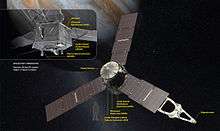JEDI

JEDI (Jupiter Energetic-particle Detector Instrument[1]), is an instrument on the Juno spacecraft orbiting planet Jupiter.[2] It is part of a suite of instruments to study the magnetosphere of Jupiter.[2]
JEDI is designed to collect data on "energy, spectra, mass species (H, He, O, S), and angular distributions";[2] the plan is to study the energies and distribution of charged particles.[3] It can detect them at between 30 keV and 1 GeV, whereas JADE, another instrument on the spacecraft, is designed to observe below 30 keV.[4] One of the concepts being studied is that energy from Jupiter's rotation is being converted into its atmosphere and magnetosphere.[4]
It is radiation hardened to collect in situ data on the planet's auroral magnetic field lines, the equatorial magnetosphere, and the polar ionosphere [2] It was built by the Johns Hopkins University Applied Physics Laboratory (APL).[5] One of the goals is to understand the aurora, and how particles are accelerated to such high speeds.[6] One of the mysteries of Jupiter is that X-rays are emitted from the poles, but do not seem to come from the auroral ring.[7]
References
- ↑ Official NASA Juno Instruments and Spacecraft diagram
- 1 2 3 4 D. K. Haggerty; B. H. Mauk; C. P. Paranicas (December 2008). "JEDI -- The Jupiter Energetic Particle Detector for the Juno mission". Bibcode:2008AGUFMSM41B1683H.
- ↑ W. Grahm (2011). "ULA Atlas V launches NASA's Juno on a path to Jupiter" (Press release). Nasaspaceflight.com.
- 1 2 NASA - Video on JEDI
- ↑ "Space scientists seek returns from JEDI" (Press release). Johns Hopkins University Applied Physics Laboratory. 5 August 2011.
- ↑ P. Gilster. "Juno: into the Jovian magnetosphere". Centari Dreams.
- ↑ "Puzzling X-rays from Jupiter" (Press release). NASA. 7 March 2002.
